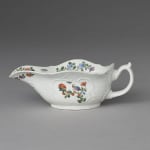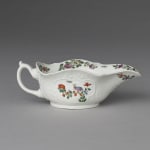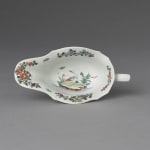


An Extremely Rare and Early Dr Wall Worcester Flat Bottomed Sauceboat, Circa 1752-1753
Further images
An Extremely Rare and Early Dr Wall Worcester Flat Bottomed Sauceboat, exceptionally well moulded in the silver taste in crisp low relief with scrolled rococo panels issuing leaves and flowers, the scrolled borderwork enclosing two panels each painted in the Chinese famille verte palette with multicoloured birds looking at insects in flight perched on flowering branches of prunus. The interior with a scene of a Crane strutting on an island issuing reeds, the border and beneath the spout decorated with trailing sprays of stylised Indianische blumen of flowering oriental plants and leaves.
Further Details: A low moulded sauceboat and only recorded in one size it is a shape that was developed at Lund’s Bristol under the keen auspices of Benjamin Lund who pioneered the development of the silver form into porcelain production through his constant evolution of paste and glaze. Invented or conceived as a shape in the late 1740’s therefore the moulds for this shape were to be transferred up to Worcester by Dr Wall and his partners for manufacturing in the new and improved paste of porcelain after February 1752 when all the Lund’s Bristol stock, moulds and undecorated porcelain were moved to Worcester. Absorbed too here are the elements chosen from a broad Chinese style and blended with the enameller’s idea of a sophisticated Meissen Indianische blumen style which is now incorporated into a style of pattern favoured at Worcester during the period of 1752-53. This blend of pattern also encapsulates a brief example of Kakiemon too in the stylised floral evocation of the chrysanthemum flowers.
Join our mailing list
* denotes required fields
We will process the personal data you have supplied in accordance with our privacy policy (available on request). You can unsubscribe or change your preferences at any time by clicking the link in our emails.


